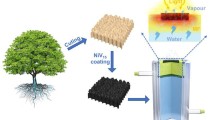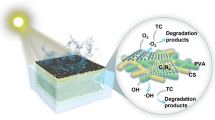Abstract
Solar desalination emerged as a promising and sustainable method for addressing the water shortage issue. Although wood can be converted to photothermal materials by surface coating and carbonization, many challenges such as the poor hydrophilicity, vulnerability to oil contamination and lipophilic micro-organisms of photothermal wood-based materials still remain. Moreover, it is difficult to form a stable chemical bond between the photothermal coating and the wood substrate, which hinders the improvement of corresponding solar evaporator. Therefore, we have prepared a wood-based solar desalination device (PPy-E-Wood) by in situ polymerization of pyrrole monomer on the pre-treated elastic wood. Successfully, efficient steam generation is achieved through the synergistic effect of the high photothermal conversion layer of PPy NPs, and the wood substrate with low thermal conductivity, micro/nano-pores and channels. The hydrophilicity and porous structure of PPy-E-Wood ensure a continuous water supply to its air–water interface, which give it a high solar conversion efficiency of 86% and an evaporation rate of 1.35 kg·m−2·h−1 under 1 kW·m−2. In addition, PPy-E-Wood has excellent structural stability, recoverability, electrical conductivity, and high salinity tolerance. Notably, the salt crystallized on its surface under ultra-high light (3 kW·m−2) can be dissolved by the natural alternation of day and night. Significantly, this wood-based photothermal material could easily realize its structural design and significantly improve its evaporation rate to 1.55 kg·m−2·h−1 or even 1.65 kg·m−2·h−1. Besides, PPy-E-Wood possesses not only the excellent superhydrophilicity and underwater superoleophobicity, but also an outstanding separation efficiency towards oil-in-water emulsions (~ 98%). We hope this work offer a new path to manufacturing and designing the wood-based photothermal materials for alleviating the global water and energy shortage.
Graphical abstract
In this study, an elastic and shape-diversified photothermal matrix material with abundant internal cellulose network was prepared by removing part of lignin from raw wood, which acted as substrate and could be designed with various structures, and loading PPy on its top by in-situ polymerization of pyrrole for achieving photothermal conversion. Under the synergistic effect of superwetting substrate and photothermal top-coating, PPy-E-Wood realize the functions of seawater desalination and oil–water separation, providing a promising solution for water purification.









Similar content being viewed by others
References
Wang B, Liang W, Guo Z et al (2015) Biomimetic super-lyophobic and super-lyophilic materials applied for oil/water separation: a new strategy beyond nature. Chem Soc Rev 44(1):336–361
Wang X, Pan Y, Yuan H et al (2020) Simple fabrication of superoleophobic PLA with honeycomb-like structures for high-efficiency oil-water separation. Chin Chem Lett 31(2):365–368
Ma W, Ding Y, Zhang M et al (2020) Nature-inspired chemistry toward hierarchical superoleophobic, antibacterial and biocompatible nanofibrous membranes for effective UV-shielding, self-cleaning and oil-water separation. J Hazard Mater 384:121476
Bartram J, Brocklehurst C, Fisher MB et al (2014) Global monitoring of water supply and sanitation: history, methods and future challenges. Int J Environ Res Publ Health 11(8):8137–8165
Eliasson J (2015) The rising pressure of global water shortages. Nature News 517(7532):6
Wang L, Boutilier MSH, Kidambi PR et al (2017) Fundamental transport mechanisms, fabrication and potential applications of nanoporous atomically thin membranes. Nat Nanotechnol 12(6):509–522
Yin J, Deng B (2015) Polymer-matrix nanocomposite membranes for water treatment. J Membr Sci 479:256–275
Wang P, Chung TS (2015) Recent advances in membrane distillation processes: Membrane development, configuration design and application exploring. J Membr Sci 474:39–56
Cohen-Tanugi D, Grossman JC (2015) Nanoporous graphene as a reverse osmosis membrane: recent insights from theory and simulation. Desalination 366:59–70
Wang Z, Yan Y, Shen X et al (2019) A wood-polypyrrole composite as a photothermal conversion device for solar evaporation enhancement. J Mater Chem A 7(36):20706–20712
Cai Y, Wu Y, Yang F, et al. Wood Sponge Reinforced with Polyvinyl Alcohol for Sustainable Oil-Water Separation. ACS Omega, 2021.
Ni G, Li G, Boriskina SV et al (2016) Steam generation under one sun enabled by a floating structure with thermal concentration. Nat Energy 1(9):1–7
Zhang P, Liao Q, Zhang T et al (2018) High throughput of clean water excluding ions, organic media, and bacteria from defect-abundant graphene aerogel under sunlight. Nano Energy 46:415–422
Shi Z, Guo J, Chen Y et al (2017) Lead-free organic–inorganic hybrid perovskites for photovoltaic applications: recent advances and perspectives. Adv Mater 29(16):1605005
Xu W, Hu X, Zhuang S et al (2018) Flexible and salt resistant Janus absorbers by electrospinning for stable and efficient solar desalination. Adv Energy Mater 8(14):1702884
Kaur M, Ishii S, Shinde SL et al (2017) All-ceramic microfibrous solar steam generator: TiN plasmonic nanoparticle-loaded transparent microfibers. ACS Sustain Chem Eng 5(10):8523–8528
Jiang Q, Derami HG, Ghim D et al (2017) Polydopamine-filled bacterial nanocellulose as a biodegradable interfacial photothermal evaporator for highly efficient solar steam generation. J Mater Chem A 10:1039
Chen C, Kuang Y, Zhu S et al (2020) Structure-property-function relationships of natural and engineered wood. Nat Rev Mater 5(9):642–666
Zhu M, Li Y, Chen G et al (2017) Tree-inspired design for high-efficiency water extraction. Adv Mater 29(44):1704107
Zhu M, Li Y, Chen F et al (2018) Plasmonic wood for high-efficiency solar steam generation. Adv Energy Mater 8(4):1701028
Liu KK, Jiang Q, Tadepalli S et al (2017) Wood-graphene oxide composite for highly efficient solar steam generation and desalination. ACS Appl Mater Interfaces 9(8):7675–7681
Kuang Y, Chen C, He S et al (2019) A high-performance self-regenerating solar evaporator for continuous water desalination. Adv Mater 31(23):1900498
He S, Chen C, Kuang Y et al (2019) Nature-inspired salt resistant bimodal porous solar evaporator for efficient and stable water desalination. Energy Environ Sci 12(5):1558–1567
Chen C, Song J, Cheng J et al (2020) Highly elastic hydrated cellulosic materials with durable compressibility and tunable conductivity. ACS Nano 14(12):16723–16734
Li J, Chen C, Zhu JY et al (2021) In situ wood delignification toward sustainable applications. Acc Mater Res 2(8):606–620
Chen C, Li Y, Song J et al (2017) Highly flexible and efficient solar steam generation device. Adv Mater 29(30):1701756
Chen C, Song J, Zhu S et al (2018) Scalable and sustainable approach toward highly compressible, anisotropic, lamellar carbon sponge. Chem 4(3):544–554
Yong J, Chen F, Huo J et al (2018) Green, biodegradable, underwater superoleophobic wood sheet for efficient oil/water separation. ACS Omega 3(2):1395–1402
Guan H, Cheng Z, Wang X (2018) Highly compressible wood sponges with a spring-like lamellar structure as effective and reusable oil absorbents. ACS Nano 12(10):10365–10373
Sun Z, Li W, Song W et al (2020) A high-efficiency solar desalination evaporator composite of corn stalk, MCNTs and TiO2: ultra-fast capillary water moisture transportation and porous bio-tissue multi-layer filtration. J Mater Chem A 8(1):349–357
Zhang H, Liu Y, Yang C et al (2018) Wafer-scale fabrication of ultrathin flexible electronic systems via capillary-assisted electrochemical delamination. Adv Mater 30(50):1805408
Zhang M, Wang CY, Ma YH et al (2020) Fabrication of superwetting, antimicrobial and conductive fibrous membrane for removing/collecting oil contaminants. RSC Adv 10:21636–21642
Zhang M, Yang QF, Gao M et al (2021) Fabrication of Janus cellulose nanocomposite membrane for various water/oil separation and selective one-way transmission. J Environ Chem Eng 9:106016
Di X, Zhang W, Jiang Z et al (2018) Facile and rapid separation of oil from emulsions by hydrophobic and lipophilic Fe3O4/sawdust composites. Chem Eng Res Des 129:102–110
Zhang M, Shi YH, Wang RJ et al (2021) Triple-functional lignocellulose/chitosan /Ag@TiO2 nanocomposite membrane for simultaneous sterilization, oil/water emulsion separation, and organic pollutant removal. J Environ Chem Eng 9:106728
Zhang L, Tang B, Wu J et al (2015) Hydrophobic light-to-heat conversion membranes with self-healing ability for interfacial solar heating. Adv Mater 27(33):4889–4894
Gan W, Chen C, Giroux M et al (2020) Conductive wood for high-performance structural electromagnetic interference shielding. Chem Mater 32(12):5280–5289
Kim K, Yu S, An C et al (2018) Mesoporous three-dimensional graphene networks for highly efficient solar desalination under 1 sun illumination. ACS Appl Mater Interfaces 10(18):15602–15608
Chen M, Wu Y, Song W et al (2018) Plasmonic nanoparticle-embedded poly (p-phenylene benzobisoxazole) nanofibrous composite films for solar steam generation. Nanoscale 10(13):6186–6193
Acknowledgements
The research was supported by the Natural Science Foundation of Jilin Province (YDZJ202201ZYTS441), National Natural Science Foundation of China (32130073, 51902006), Science and Technology Research Project of Jilin Province Education Department (JJKH20210050KJ), Science and Technology Innovation Development Plan of Jilin City (20200104083), State Key Laboratory of Bio-Fibers and Eco-Textiles (K2019-08), Project of Jilin Province Science and Technology Development Research (20210202068NC) and Fundamental Research Funds for Wood Material Science and Engineering Key Laboratory of Jilin Province.
Author information
Authors and Affiliations
Corresponding author
Ethics declarations
Conflict of interest
The authors declare that they have no known competing financial interests or personal relationships that could influence the work reported in this paper.
Additional information
Handling Editor: Stephen Eichhorn.
Publisher's Note
Springer Nature remains neutral with regard to jurisdictional claims in published maps and institutional affiliations.
Supplementary Information
Below is the link to the electronic supplementary material.
Rights and permissions
Springer Nature or its licensor holds exclusive rights to this article under a publishing agreement with the author(s) or other rightsholder(s); author self-archiving of the accepted manuscript version of this article is solely governed by the terms of such publishing agreement and applicable law.
About this article
Cite this article
Shi, L., Zhang, M., Du, X. et al. In situ polymerization of pyrrole on elastic wood for high efficiency seawater desalination and oily water purification. J Mater Sci 57, 16317–16332 (2022). https://doi.org/10.1007/s10853-022-07632-8
Received:
Accepted:
Published:
Issue Date:
DOI: https://doi.org/10.1007/s10853-022-07632-8




